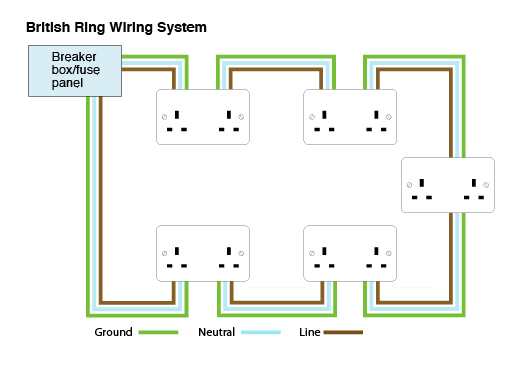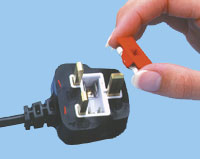Firstly this is in no way comparable to house wiring beyond having a few common components. Inside a car fusebox there will be at least two power feeds: Always on, and on only when the key is turned on (switched). Some of the newer cars have delayed off circuits which could add other power feeds into the fusebox. In some older cars these feeds are done with wire jumpers, not buss bars, although the functioin is exactly the same. All we need to know about this is that the power feed goes to one side of any given fuse, and the other side of that fuse goes to the load.
To make this easy to understand I'll use "12V" to identify the power feed to the fusebox, whether always on, switched, or delayed. So your interior dome lights go like this:
12V to fuse, other side of that fuse (downstream side) to the door switches, then from there to the dome light. Should an overload or short occur anywhere past the other "downstream" side of this fuse, the fuse will blow to protect the fusebox and other car wiring.
Now let's consider adding onto this. The car was designed so that the wiring in this circuit could sustain normal operation of the dome light at the expected load without the fuse blowing. If we add our new load to the 12V side of the fuse, the original car fuse for that circuit is not protecting the new load, but it stil protects the dome light circuit. If our new load shorts or overloads the circuit, the fusebox and car wiring will see that load unprotected and you've got problems.
Now lets add a fuse for our new load so that an overload or short in the new circuit will cause the new fuse to blow before the fusebox and car wiring are affected. You might think you're protected but you're not, because we haven't accounted for the extra power being used by the new load during normal operation. When that is added to the power used by dome light operation, you might be overloading the 12V power feed at the fusebox which was not designed to have this extra power drawn from it. Being that our new load is a dashcam which uses little power, there is probably enough capacity for it's new load but we cannot know this for certain. We have now increased the total load.
So let's change the new load to the other "downstream" side of the dome light fusewithout adding a new fuse for it. Now if the new load shorts or overloads, it has only the dome light fuse to protect the fusebox and car wiring, and the dome light fuse will protect these adequately, but it will not protect the new load wiring and load that is not designed to handle as much power as the dome light normally uses and is fused for. During normal operation the total load is the same as before. It is only when the new load malfunctions that we have a problem.
Now let's add a fuse to our new load which is now drawing power fron the "downstream" side of the larger dome light fuse. Again the total load remains the same during normal operation, but that total load my now be more than the car fuse can tolerate, thus it might blow without any malfunctions occuring. Normally the car fuse and wiring will have some extra capacity designed in so that increased resistance over time due to wire and connector aging will be handled while still covering a larger overload. If a short or overload occurs in the dome light circuit, the dome light fuse will blow and now our new load has lost it's power source, but the fusebox and car wiring go unharmed so we don't have a problem other than the loss of function of our new load (dashcam). Now instead of a malfunction in the dome light, lets consider it working normally and having an overload or short occur in our new load, whose fuse is smaller in capacity than the dome light fuse feeding it. This will blow the smaller fuse of the new load before affecting the dome light fuse, the fusebox, or the car wiring. The only problem we have is loss of function of the new load (dashcam) and the dome light will still function normally.
Now lets consider that everything is functioning normally in both the dome light circuit and with the new load, both of which are fused appropriately as shown above. Can we possibly have a problem? Yes, and here's why- we have increased the normal load into a higher total load which the 12V at the fusebox must supply. If it cannot supply the total power safely, then we can have a problem even with no fuses blowing and with everything functioning normally. Since we cannot know for certain whether the 12V at the fusebox can tolerate the added load there is still some risk, but being that our new load is a dashcam using very little power, this risk is very minimal. In engineering electrical circuits, thr normal practice is to size the wire to meet the expected load, then fuse at a level which will carry the expected load, but with a small safety margin built in because when the wiring and the fuse are the same rating it is impossible to be certain that the fuse will blow before the wiring gets harmed. So the wiring feeding any fuse in a car will be able to carry more power than the fuse does, even if only slightly. Since our power needs for a dashcam is also slight it's very unlikely that our new total load will exceed the ability of the car wiring to handle it safely. If we fuse things like I last described here, each circuit we're playing with will be protected with the lowest possibility of one malfunction causing another malfunction.
So as I posted before, the safest way to do this has this power flow: 12V > domelight (or other) car fuse > dashcam fuse > dashcam.
It is not the only way, and as I've shown above the car can be protected doing this differently, but this is the best way for the reasons already noted. Being that our power requirements are so small, I would not worry if we cannot determine which side of a car fuse is 12V and which side is downstream, since our smaller cam fuse will blow if it has a problem which protects the car anyway and that is our main goal.
Just remember that I've shown where even normal operation could possibly cause the car fuse to overload and blow, which is why you never want to tap into any fuse which could affect safe car functioning such as exterior lighting, engine controls, or airbags. This is the most important part of doing a dashcam install safely so never break this rule even if no other suitable power source can be found. Better to be safe without your cam than to risk death or injury just to have it.
Whew, I feel like I've just written a term paper for college but I hope that everyone can now understand what we're dealing with and how to best do it safely with the least risks in everything.
Phil



